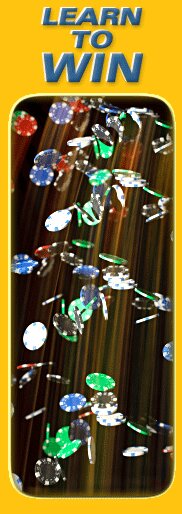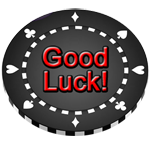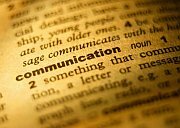Craps Don't Strategies
by Frank Scoblete
In this Learn to Play Craps lesson, we explore Craps Don't Strategies.
The enemy of the Craps Don’t or Darkside player is the shooter who gets hot.
A shooter hitting point after point, number after number, can drown a Darkside player.
What makes Rightside bettors cheer with abandon will make a Darkside player groan.
While the math of craps shows that there is very little difference in the long-term expectation between the Rightside and the Darkside of craps, the math also shows that the pattern of how a Darksider wins contrasted with how a Rightsider wins is markedly different.
On the Darkside, for example, a Craps Don’t Pass or Craps Don’t Come bet will face a strong losing potential when it is first placed because of the deadly effect of the 7 and 11.
That duo can appear eight times, all losers, for every three wins (the 2 or 3) on the initial placement of the bet. Once up on the number, of course, the Darksider has the best of it since he is favored to win on every number.
Most Darkside Don’t Pass and Don’t Come players like to do the mathematically correct thing by laying odds on their bets once they are up on the numbers.
Of course, a single loss on the number requires two wins to make up for it, whereas on the Rightside a player taking the odds needs only to win one bet to make up for one loss and show a profit.
That’s because he is not the favorite to win an equal number of bets in the long run. Thus, his taking of the odds means he wins more than even-money when he does win.
The Darksider loses the whole bet but only wins a fraction of his odds when he does win.
But there is a relatively simple way to avoid all hot shooters.
Don’t bet on the Don’t Pass!
Do bet on the Don’t Come!
These simple rules will avoid all hot rolls by an individual shooter and, just as important, if there are any controlled shooters at the table, these rules will help you avoid them as well – at least when they are deliberately setting and shooting against your interests.
Some Darksiders have fallen for the logical fallacy that a shooter can’t make enough “points” to hurt you if you keep escalating your bets in a Martingale (i.e., a double up as you lose progression) in order to recoup in one win what you lost in all those losses.
This is not so. A shooter need only make seven points to put you at the table maximums in most casinos if you are starting with $10 Don’t Pass bets and backing them with full odds.
Even though this will not happen that often, it will happen on occasion and those occasions will be enough to wipe out all the little wins you accumulated over time with your Martingale.
The way you avoid betting on hot shooters is to figure that anyone who has burned you once is just as likely to burn you twice.
The Don’t Pass line, where the 7 and 11 come up with annoying regularity, is just asking for the same shooter to burn you once, twice, thrice and even more.
Why? Because a controlled shooter will often be looking to hit that 7 and will therefore be setting for the 7.
The Don’t Come, while mathematically the exact same bet as the Don’t Pass, has certain features that make it a more attractive bet for the Darksider looking to minimize his exposure to hot shooters or dice controllers.
First of all, while the bet loses on a 7 or 11 in its initial placement, the 7, which will occur three-fourths of the time on a loser, knocks off the shooter; he sevens out.
This shooter will therefore only be able to hurt you once on a 7, unlike the Craps Don’t Pass shooter who can roll many 7s in a row to frustrate and aggravate you. My advice, if the 11 shows, is to take it as a warning and not bet against this particular shooter again.
Now, if the shooter is a controlled shooter, when your Don’t Come bet is out there, it is highly likely that the dice controller is looking to hit any number but the 7.
If he has skill, it is much more likely that he will be reducing the appearance of the 7 and increasing the appearance of the other numbers.
Thus, you face reduced chances of being burned on the initial placement. Once up on a number, you still have to worry that a dice controller will bang you out but at least you made it to the point in the game where you have the math with you. If a shooter should hit the number you’re on, that’s it for him. He beat you; accept it. Wait for another shooter.
By playing this way, any one shooter can only hurt you once, whether he rolls for a minute or until the end of time.
To take a beating on the initial placement of the Don’t Pass can happen over and over.
To take a beating on the initial placement of the Don’t Come rarely happens because three-fourths of the time it is a seven out.
If you have been playing craps for any sustained length of time, you know that it is rare that any shooter has an epic roll; rarer still that two or three will have them back to back to back.
Playing Craps Don’t in such a conservative fashion will not win you buckets of chips but it will prevent you from losing barrels full of them to a shooter who is hot.
Craps Don’t Strategies is followed by Aggressive Craps
OR
Return to Learn to Play Craps Program
Gambling Teachers home
GT is attentive about getting the word out about our free programs, lessons and add-ons offered, however, we ask your assistance and consideration in promoting us.
Click link below that reads, "Enjoy this page? Please pay it forward. Here's how..." to add a link to your site, blog or personal page.
Tips, Terms & Wins
Craps Numbers: 12 is the outermost in craps numbers along with the 2.
It can only be made one way: 6:6. It is affectionately known as “boxcars”.
On the come-out roll, it loses for the Pass Line bettor but pushes for the Don’t Pass bettor.





